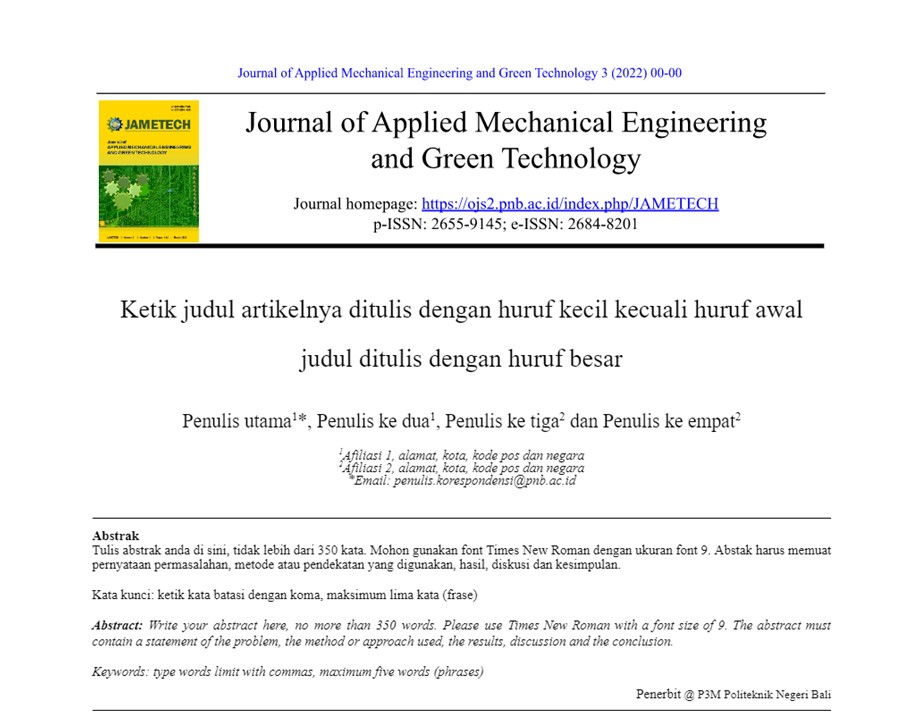Author Guideline
General Guidelines
Manuscripts must be submitted online. Once authors have prepared the manuscrips according to the instructions or Article Template, please visit the JAMETECH online submission web-site. As part of the submission process, authors are required to check their submission's compliance with all of the following items. The submissions may be returned to authors that do not adhere to the guideline.
JAMETECH receives manuscripts contain scientific research results or simulations in the fields of Mechanical Engineering, Green Technology and associated fields include Mechanics, Materials, Manufacturing and Production, Design and Construction, Automotive, Refrigeration Heating Ventilating and Air Conditioning (RHVAC), Mechanical, Electrical and Plumbing for Buildings, Sustainable Energy Management and Technology, New, and Renewable Energy Technologies.
Detailed Guidelines:
- The manuscript should be original and has not been published or under review elsewhere.
- Manuscript should be between 5 and 8 pages long, single line spacing, Times New Roman, font size 10 (except for abstract font size 9).
- The title should be concise and clear consisting of not more than 15 words, typed in lower case and capitalize the first letter font size 17.
- No academic degree should be attached to author names. In cases where the authors come from different institutions, an index should be used after each name. The style for the names is initials then surname, with a comma after all but the last two names are separated by ‘and’. Initials should have full stops.
- Below the author name(s) should be written their academic affiliation
- Corresponding email address and contacts should be place in a foot note of the first page
- Further detailed guideline can be seen on the Article Template of the Journal of Applied Mechanical Engineering and Green Technology.
The manuscript should also contain the following:
- Abstract, maximum 350 words with keywords ordered according to their importance, Times New Roman, font size 9.
- Introduction, describing the background, problem, aim(s) and significance of the study.
- Methods, containing detailed and clear description of the instrument(s) and methods of data collection and analysis used in the study.
- Results and Discussion, containing results of the study and their discussion. The discussion should be related to the previous findings, both of the author’s past research or other researchers’. Avoid repetition of the same statement previously mentioned.
- Conclusion, containing summary of main findings of the study and suggestion for further study. Avoid repetition of the same sentences written previously under Results and Discussion section.
- Acknowledgement, addressing those who have provided assistance in the form of either research facilities or funding, as well as those who have helped during the manuscript preparation. Acknowledgment section immediately following the last numbered section of the paper and have no number.
- References, adopting the IEEE style where references are numbered sequentially throughout the text. The numbers occur within square brackets. References contain only those works cited in the text.
The similarity of the paper should be checked by using Plagiarism Checker Software which is an electronic text matching system that compares text in the paper against a database of sources.
As a guide: a Similarity Index of below 15% would probably indicate that plagiarism has not occurred. However, if the 15% of matching text is one continuous block this could still be considered plagiarism. A high Similarity Index would probably be anything over 25% (Yellow, orange or red). Papers with similarity index more than 25% will be asked for revision to meet the requirement.






